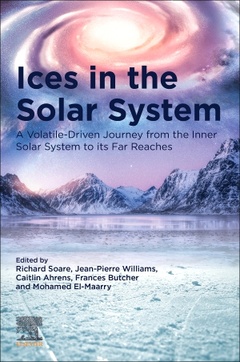Ices in the Solar-System A Volatile-Driven Journey from the Inner Solar System to its Far Reaches
Coordonnateurs : Soare Richard, Williams Jean-Pierre, Ahrens Caitlin, Butcher Frances, El-Maarry Mohamed Ramy

Ices in the Solar System: A Volatile-Driven Journey from the Inner Solar System to Its Far Reaches explores the origins, evolution and distribution of various ice species throughout the solar system. Geographically, the book?s focus on ice(s) migrates outwardly from Mercury, the Earth and the Moon, Mars, then Ceres and other volatile-rich small bodies; it carries on with the moons of Jupiter, Saturn, and Uranus, followed by Pluto and other Kuiper Belt/Trans-Neptunian objects. Conceptually and empirically, the book depicts the often-enigmatic narratives of the different ice species (H2O, CO2, CH4, etc.) in the solar system and examines their interaction with a wide range of surface, near-subsurface, interior and atmospheric processes.
Introduction Prologue I: The Solar System’s ices and their origin Prologue II: The Ice Frontier for Science in the Upcoming Decades: A strategy for Solar System Exploration? 1: Cold-trapped ices at the poles of Mercury and the Moon 2: Glacial and periglacial processes on Earth 3: Mars, glacial (early) 4: Glacial deposits, remnants and landscapes on Amazonian Mars: Using setting, structure, and stratigraphy to understand ice evolution and climate history 5: Evidence, arguments and cold-climate geomorphology that favour periglacial cycling at the Martian mid-latitudes in the Late Amazonian Epoch 6: Ice exploration on Mars: whereto and when? 7: Ceres - Remnants of an ancient ocean world 8: Small icy bodies in the inner solar system 9: Icy ocean worlds in the Jupiter system 10: Titan, Enceladus and other icy moons of Saturn 11: Cryogeology of KBO Pluto and the icy satellites of Uranus and Neptune
Richard Soare is a physical geographer specializing in periglacial (cold-climate, non-glacial landscapes). Through the last twenty years he has spent considerable time in the Canadian arctic (physically) and off-planet (intellectually), attempting to identify landscapes on Mars present or past possibly molded by the freeze-thaw cycling of water. His work spans the red planet geographically, ranging from the plains of Utopia Planitia in the northern hemisphere and the Moreux impact-crater at the Mars dichotomy through to the Argyre impact-crater in the southern hemisphere. Recently, he lead-edited “Mars Geological Enigmas: from the late Noachian Epoch to the present day and a special issue of Icarus: “Current and Recent Landscape Evolution on Mars.
Jean-Pierre Williams is a planetary scientist at the University of California in Los Angeles (UCLA). He received his PhD in Geophysics and Space Physics from UCLA and was a research scientist at the California Institute of Technology (Caltech) for five years before accepting a position at UCLA. His work focuses on the geology and physics of the inner planets, and he has authored and co-authored over sixty peer-reviewed publications on Mars, Mercury, and the Earth’s Moon. He is currently the Deputy Principal Investigator of the Diviner Lunar Radiometer Experiment on the Lunar Reconnaissance Orbiter, a member of the ShadowCam instrument team on the Korean Pathfinder Lunar Orbiter (Danuri) mission, which will image the permanently shadowed regions near the poles of the Moon, and a Co-Investigator of the Lunar Vulkan Imaging and Spectroscopy Explorer (Lunar-VISE), a lander and rover that will explore the summit of a volcanic dome on the Moon.
Caitlin Ahrens is a postdoctoral research scientist at NASA Goddard Space Flight Center, Greenbelt, Maryland. Dr. Ahrens received her B.S. in Physics/Astrophysics and Geology from West Virginia University in 2015, and a Ph.D.
- • Draws a pan solar-system view of various ice species • Identifies and addresses outstanding and sometimes puzzling questions about these ices • Describes the dynamic relationships between these ices and the geological history of the planets, moons, and smaller bodies where they occur • Studies these relationships using multiple analytical-scales and techniques
Date de parution : 12-2023
Ouvrage de 418 p.
15.2x22.8 cm
Thème d’Ices in the Solar-System :
Mots-clés :
Ice; ice ages; Earth and Mars; icy planetary surfaces; icy moons; Jupiter and Saturn


